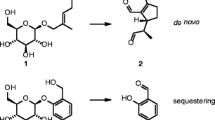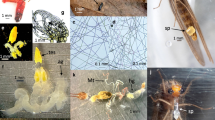Abstract
We determined the protective values of histamine and linamarin to an aposematic moth,Zygaena filipendulae. Using ion-exchange resin techniques, we found that the mean histamine concentrations in the wings were 0.061 ± 0.047 μg/mg and 0.013 ± 0.0051 in the moths' bodies (totals: 0.586 μg and 2.921 μg, respectively, all wet weights). Average HCN evolution (mainly from the bitter cyanogen linamarin) from the wings was 0.049 ± 0.41 μg/mg (0.426 μg/ml of linamarin could produce this amount of HCN) and 0.029 ± 0.0026 μg/mg HCN (0.281 μg/mg linamarin) evolved from the bodies (total linamarin 4.09 μg and 61.258 μg, respectively, all wet weights). Therefore, higher concentrations of toxicants were found in the part of the body most liable to initial attack. We found, in offering various toxic solutions to 10 common quails, that 0.1% linamarin (mean linamarin consumed equal to about 70% of the average total wing content) but 1.0% histamine (mean histamine consumed equal to that found in about 8.9 average wing sets) solutions significantly lowered drinking rates. However, combination solutions were still effectively aversive at 0.001% histamine plus 0.028% linamarin. This synergism would allow a moth under local abiotic or dietary stress to elaborate substantially less of one or both compounds than that normally synthesized. The implications to kin selection are discussed.
Similar content being viewed by others
References
Alcock, J. 1970. Interspecific differences in avian feeding behavior and the evolution of Batesian mimicry.Behaviour 40:1–9.
Brower, L.P. 1969. Ecological chemistry.Sci. Am. 220:22–30.
Brower, L.P., andGlazier, S.C. 1975. Localization of heart poisons in the monarch butterfly.Science 188:19–25.
Davis, R.H., andNahrstedt, A. 1979. Linamarin and lotaustralin as the sources of cyanide inZygaena filipendulae (L).Comp. Biochem. Physiol. 64(B):395–398.
Davis, R.H., andNahrstedt, A. 1981. Occurrence and variations of the cyanogenic glycosides linamarin and lotaustralin in species of the Zygaenidae.Comp. Biochem. Physiol. 71(B):329–332.
Davis, R.H., andNahrstedt, A. 1984. Cyanogenesis in insects,in G.A. Veshut and L.I. Gilbert (eds.). Comprehensive Insect Physiology, Biochemistry, and Pharmacology, Vol. 11, 198–221. New York, Pergamon Press.
Di Giovanni, M., andBrodie, E.D. 1981. Efficacy of skin glands in protecting the salamanderAmbystoma opacum from repeated attacks by the shrewBlavina brevicauda.Herpetologica 37:234–237.
Evans, D.L. 1978. Strategies for survival. PhD thesis. University of Illinois, Urbana.
Evans, D.L. 1983. Relative defensive behavior of some moths and the implications of predatorprey interactions.Entomol. Exp. Appl. 33:103–111.
Evans, D.L., Castoriades, N., andMuhtasib, H. 1985. Is the six-spotted Burnet moth,Zygaena filipendulae, a part of theCercopis intermedia Mullerian mimicry complex?Leb. Sci. Bull. 1:65–71.
Evans, D.L., Castoriades, N., andBadruddin, H. 1986. Cardenolides in the defense ofCaenocoris nerii.Oikos 46:325–329.
Feldstein, M., Klenskoj, N.C., andBuffalo, N.Y. 1954. The determination of cyanide in biologic fluids by microdiffusion analysis.J. Lab. Clin. Med. 44:166–170.
Frazer, J.F.D., andRothschild, M. 1960. Defense mechanisms in warningly coloured moths and other insects.Proceedings, XIth International Congress on Entomology Vienna 3:249–259.
Järvi, T., Silleń-Tulberg, B., andWiklund, C. 1981. The cost of being aposematic. An experimental study of predation on larvae ofPapilio machaon by the great titParus major.Oikos 37:267–272.
Jones, D.A., Parsons, J., andRothschild, M. 1962. Release of hydrocyanic acid from crushed tissues of all stages in the life cycle of species of the Zygaeninae (Lepidoptera).Nature 193:52–53.
Lea, R., andTurner, J.R.G. 1972. Experiments on mimicry. II. The effect of a Batesian mimic on its model.Behaviour 42:131–151.
Pasteels, J.M., Daloze, D., Van Dorsser, W., andRoba, J. 1979. Cardiac glycosides in the defensive secretion ofChysolina herbacea. Identification, biological role and pharmacological activity.Comp. Biochem. Physiol 63(C):117–121.
Philbrick, D.J., Hill, D.C., andAlexander, J.C. 1977. Physiological and biochemical changes associated with linamarin administration to rats.Toxicol. Appl. Pharmacol. 42:539–551.
Ressler, C. 1962. Isolation and identification from common vetch of the neurotoxin β-cyano-l-alamine; a possible factor in neurolathyrism.J. Biol. Chem. 237:733–735.
Robinson-White, A., andBeavan, M.A. 1982. Presence of histamine and histamine-metabolizing enzyme in rat and guinea pig microvascular endothelical cells.J. Pharmacol. Exp. Ther. 217:440–445.
Rothschild, M., Reichstein, T., Euw J. Von, Aplin R., andHarman, R.R.M. 1970. Toxic Lepidoptera.Toxicon. 8:293–299.
Schuler, W. 1983. Responses to sugars and their behavior mechanisms in the starling (Sturnus vulgaris L.).Behav. Ecol. Sociobiol. 13:243–251.
Sekardi, L., andFriedberg, K.D. 1981. A simplified method for the extraction and isolation of histamine from whole blood, plasma, and tissues for fluorometric histamine analysis.Pharmacology 24:35–56.
Sokal, R.R., andRohlf, F.J. 1980. Biometry, 2nd ed. W.H. Freeman, San Francisco.
Wiklund, C., andJärvi, T. 1982. Survival of distasteful insects after being attacked by naive birds: A reappraisal of the theory of aposematic coloration evolving through individual selection.Evolution 36:998–1002.
Witthohn, K., andNaumann, C.M. 1984. Qualitative and quantitative studies on the compounds of theZygaena trifolii (Esper., 1983).Comp. Biochem. Physiol. 79(C): 103–106.
Author information
Authors and Affiliations
Rights and permissions
About this article
Cite this article
Muhtasib, H., Evans, D.L. Linamarin and histamine in the defense of adultZygaena filipendulae . J Chem Ecol 13, 133–142 (1987). https://doi.org/10.1007/BF01020357
Received:
Accepted:
Issue Date:
DOI: https://doi.org/10.1007/BF01020357




